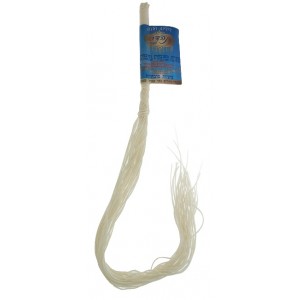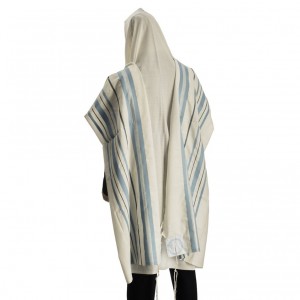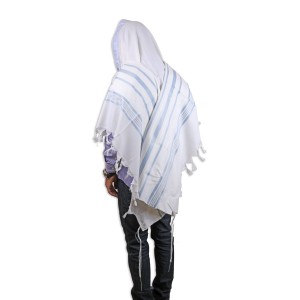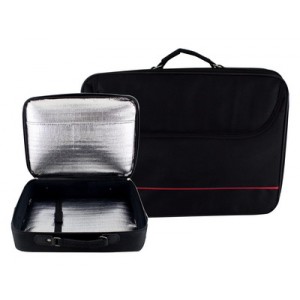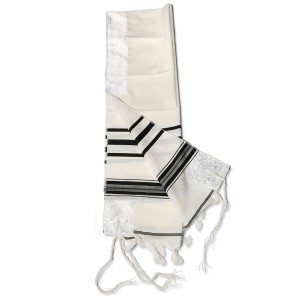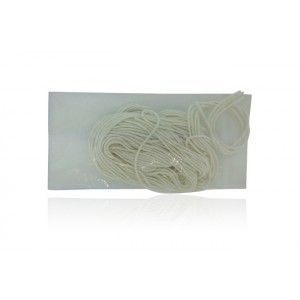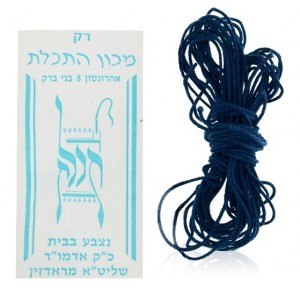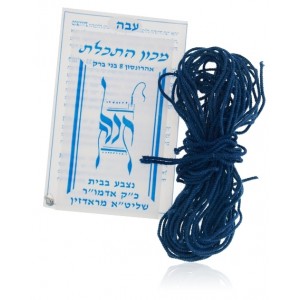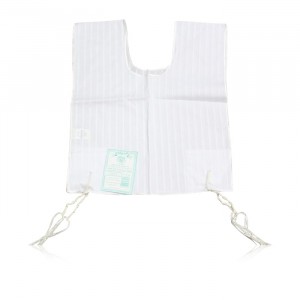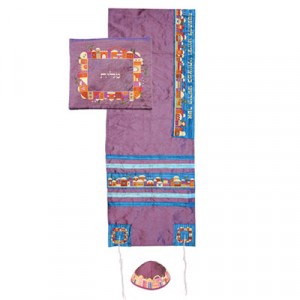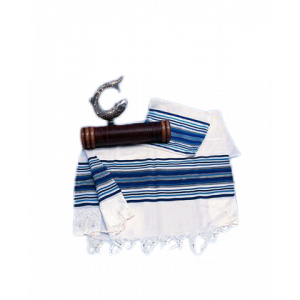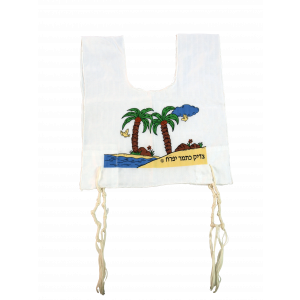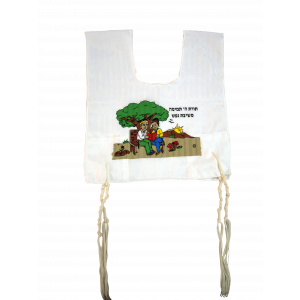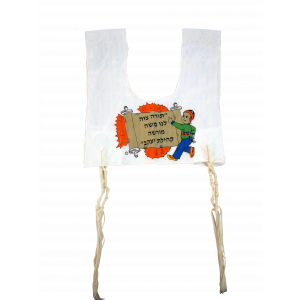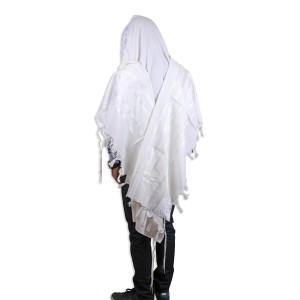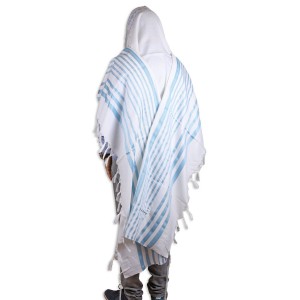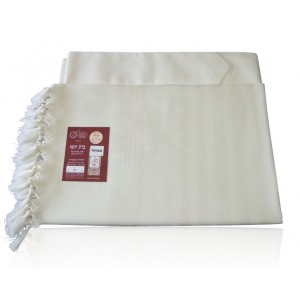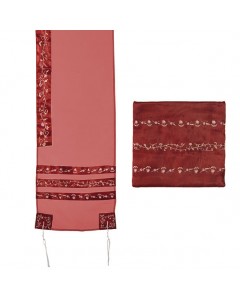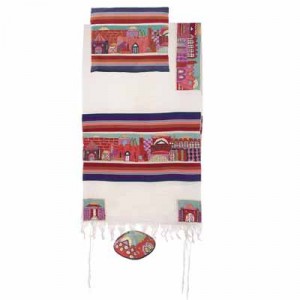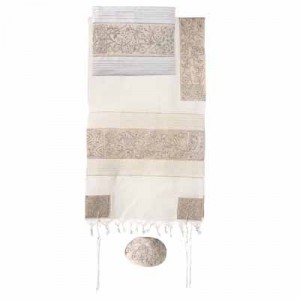Tallit
There is a mitzvah, or commandment, in Judaism for men to wear to fringes on a four-cornered garment. In the modern age, it is uncommon for people to wear this type. So in order to fulfill this mitzvah, men wear a garment on themselves known as Tzitzit and attach fringes with the same name to the garment. In addition to this, men also wear a four-cornered garment called a Tallis during prayer services. There are different types of Tallitot and the most common of these Tallitot is the traditional Tallit.
More than the Tallit itself are actually the fringes, tzitzit and techelet, attached to the tallit at its four corners. White or white and blue, these fringes are called Tzitzit and they are as reminders of the Covenant between man and God, a sign of commitment to following and keeping the Mitzvot and commandments in one’s life. The fringes are made of refine wool and will often say if the man wearing them is of Sephardic or Ashkenazi community and reflect his level of observance. Thin tzitzit will be a better choice for Tallit Katan, whereas on Tallit Gadol, both are fine. Thin Tzitzit are often machine-spun (machine-made), while thick tzitzit are handmade, and also called ‘Avodat Yad’. In traditional Orthodox congregations, thick tzitzit are the norm. Among the Modern Orthodox, you will see both, although thick tzitzit are probably more common.
There are three main shitot (methods) how to wrap the strings: Ra’avad, Rambam and Radzyner to tying the techelet and tzitzit strings. To learn more about these methods read our more detailed article on Tzitzit & tekhelet.
The traditional Tallit is made from wool – usually Turkish wool – because it is considered to be one of the highest quality wools available. In addition, this Tallis is typically large enough to cover the head and most of the body. The traditional Tallit is typically worn with the top covering the head and then rest of the garment draped over the body, covering the shoulders and back. This Tallit typically has stripes that are usually black, blue or white; although it is possible to find Tallitot with stripes in gold, maroon or silver. The striping pattern is based on Jewish heritage and tradition with typical traditional designs being Chabad, Ashkenaz, Sefard and Yemenite. Learn more about the Tallit, tzitzit, attarah and how to wear it in our ultimate tallit guide that will shed light on this garment and meaning. Learn more about Tallit Katan and Tallit Gadol, as well as the difference between Sephardic and Ashkenazi Tallit in our article about tallis, on OyVey, our Jewish blog.
In terms of the Tzitzit strings, there are several options available. Although the traditional Tallis usually comes with strings tied to the corners, it is possible to purchase a Tallit without strings. Many Jewish men will replace the strings with a different, often much nice, set of tzitzit strings. The strings are usually thick or thin with the thicker strings also being considerably. In addition, it is possible to purchase Tallitot with the Techelet string attached. The tradition of how the strings are tied vary and thus it is possible to find Tallitot with Tzitzit tied in different ways such as Rashi, Arizal, Rambam, Ra’avad, to name a few. Finally, the corners of the Tallis are usually strengthened with an extra piece of cloth attached. This prevents the Tzitzit from tearing Tallit due to wear and subsequently falling off.
If you would like to personalize your Tallit, there are several options available. One of the simplest options is to have your name sewn into the top of the Tallit. Another option is to attach an Atara – which is a piece of cloth that is attached to the top edge of Tallitot. The Atara usually has silver links attached to it or is made of silk and depicts something related to Judaism. Sterling silver Ataras are usually made of silver links which are usually square or shield shaped. The links are sewn into the Atara and can be patterned to create flowers or diamonds. Silver ataras usually depict Jerusalem or something related to Judaism.
Tallit Guide
One of the most well known Judaica items that can be found in a synagogue other than Torahs and prayer books is the Tallit, also known as the prayer shawl.
What is a Tallit?
A Tallit is large four cornered garment that is worn by Jewish men during prayers during the week, Shabbat and Jewish Holidays. The Tallit is typically made from wool and is dyed white. It can actually be made of other material as well, although it may never be made from a combination of wool and linen due to a Biblical prohibition wearing such cloth. Depending on the community, the Tallit may be worn from the age of 7, Bar Mitzvah or after marriage. In some communities, the Tallit is also used in a wedding ceremony, being worn by the groom or used as the canopy used in the Chuppah service.
Sizes & Decorations
Tallits vary in size as they are designed to fit each person. The size also depends on the sect of Judaism as there are two different ways to wear a Tallit. The first style is to wear the Tallit as if it were a scarf. This style is popular in Reform, Reconstructionist and some Conservative groups of Jews. The other style is the traditional one in which the wearer folds the sides over the shoulders. This style is used by Orthodox, Traditiona/Masorati and Conservative Jews. The traditional Tallit tends to be larger than its modern counterpart. The sizes are as follows:
Scarf (Modern) Style Tallit Sizes:
|
Inches |
Centimeters |
Height |
Body Type |
|
19 x 61 |
46 x 153 |
5 ft. |
Bar Mitzvah |
|
18 x 73 |
46 x 153 |
Under 6 |
Tall Bar Mitzvah |
|
23 x 73 |
56 x 183 |
6 ft. |
Around 6 ft. |
|
26 x 73 |
66 x 183 |
6 ft. |
Adult 6 ft. |
|
37 x 73 |
92 x 183 |
Over 6 ft. |
Large Adult |
|
24 x 79 |
61 x 199 |
Over 6 ft. |
Adult, thin, 6 ft. |
|
28 x 79 |
69 x 199 |
Over 6 ft. |
Adult large, 6 ft. |
Traditional Style Tallit Sizes:
|
Inches |
Centimeters |
Height |
Type of Person |
|
37 x 72 |
92 x 183 |
5 ft. |
Bar Mitzvah |
|
44 x 73 |
111 x 183 |
5.5 ft. |
Tall Bar Mitzvah |
|
55 x 73 |
138 x 183 |
Under 6 ft. |
Adult |
|
61 x 79 |
153 x 199 |
Over 6 ft. |
Large Adult |
|
73 x 85 |
183 x 214 |
Over 6 ft. |
Extra Large Adult |
The Tallit can be decorated with a wide range of scenes and Judaica objects. However, there are few decorations that all Tallitot share. The first decoration is the center of the top edge, which features a second piece of cloth that is typically embroidered with a floral pattern and sometimes has the blessing that is made before wearying the Tallit embroidered in a color such as black and or blue.
The second decoration found in all Tallitot is stripes that run along the sides. The stripes can be nearly any color, but are usually blue, black or white. However, they may be other colors such as green and red. Some Tallitot are multicolored, having stripes in numerous colors and is meant to echo Joseph’s coat. Other common decorations on the Tallit’s top edge and sides are views of Jerusalem, the Seven Species.
Atara
In addition to having stripes and a decorated top edge, some Tallits have a specially made Atara, or “tiara” in English. The Atara is a long piece of cloth that usually features sterling silver decorations, typically plates in triangles, squares or stitched sterling silver thread that creates a floral pattern. The Atara, while not a required part of the Tallit, is very popular amongst many groups of Jews.
Strings
The Tallit typically comes with strings tied to each of its corners. The strings tied to the corners follow the same rules as those on Tzitzit and may be tied in several different ways, keeping in line with the valid rulings issued by past Jewish leaders such as Rashi, Rambam (Maimonides), Arizal and others. In addition, one may tie strings with Techelet to its corners just like by Tzitzit.
For More Information
For more information on Tallitot, Judaica Items, or synagogue items, feel free to contact our Judaica experts with any questions or concerns.

